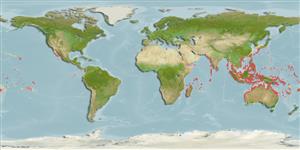Common names from other countries
Classification / Names / Names
Namen | Synonyme | Catalog of Fishes (gen., sp.) | ITIS | CoL | WoRMS
Environment: milieu / climate zone / depth range / distribution range
Ökologie
; tiefenbereich 0 - 20 m (Ref. 349). Tropical
Indo-Pacific.
Length at first maturity / Size / Gewicht / Alter
Maturity: Lm ? range ? - ? cm Max length : 11.0 cm SHL Männchen/unbestimmt; (Ref. 349); common length : 8.0 cm SHL Männchen/unbestimmt; (Ref. 349)
Traditionally used in Melanesia for the decoration of boats. Occasionally used as food, but mainly collected for its shell (Ref. 349). In shallow waters, it is near black, soft corals or sponges (Ref. 799). Common on the large fleshy soft coral Sarcophyton (Ref. 349).
Life cycle and mating behavior
Geschlechtsreife | Fortpflanzung | Ablaichen | Eier | Fecundity | Larven
Members of the order Neotaenioglossa are mostly gonochoric and broadcast spawners. Life cycle: Embryos develop into planktonic trocophore larvae and later into juvenile veligers before becoming fully grown adults.
Poutiers, J.M. 1998. (Ref. 349)
IUCN Rote Liste Status (Ref. 130435)
CITES Status (Ref. 108899)
Not Evaluated
Not Evaluated
Bedrohung für Menschen
Harmless
Nutzung durch Menschen
| FishSource |
Tools
Mehr Information
Alter/GrößeWachstumLänge-GewichtLänge-LängeMorphologieLarvenDichte
Internet Quellen
Estimates based on models
Preferred temperature
(Ref.
115969): 24.2 - 29.3, mean 28.4 (based on 3368 cells).
Verwundbarkeit
Low vulnerability (10 of 100).
Preiskategorie
Unknown.
